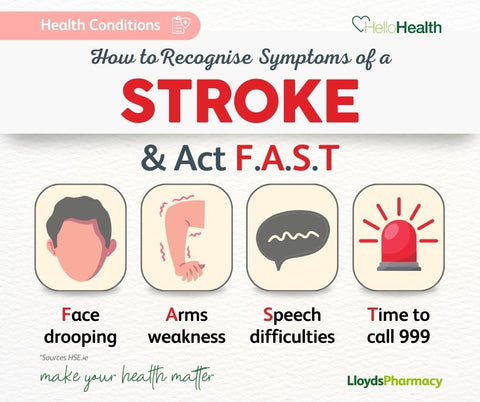Act FAST: Recognising Signs, Causes, and Prevention of Strokes

What is a stroke?
A stroke is a serious life-threatening medical condition. It occurs when there is a sudden interruption of blood flow to the brain, also known as a brain attack, which leads to brain cell death and potential permanent brain damage. It's crucial to recognise the signs and symptoms of a stroke as quickly as possible so you can seek immediate medical attention and reduce the risk of long-term complications.
Strokes are a medical emergency and urgent medical attention is needed. If you suspect you or someone you know is suffering from one, phone 999 or 112 immediately and ask for an ambulance.
Signs of Strokes
When trying to determine if you or someone else is suffering from a stroke, remember the word FAST.
Face – has their face dropped on one side? They may not be able to smile, or their mouth or eyelid may have drooped.
Arms – can they lift both their arms and hold them up? A stroke may cause weakness or numbness in one arm.
Speech – has their speech become slurred or garble? A stroke may also leave the patient unable to talk at all.
Time – call 999 or 112 immediately if you feel you or someone you know is suffering from any of these symptoms. Time is of the essence when it comes to treating a stroke and prompt treatment can reduce the severity of symptoms and improve the chances of recovery.

Common symptoms of stroke can include the following
- Numbness, weakness, or paralysis on one side of the body
- Slurred speech, difficulty thinking of words or understanding other people
- Confusion
- Sudden blurred vision or sight loss
- Being unsteady on your feet
- Severe headache
Types and Causes of Strokes
There are two types of strokes.
Ischaemic strokes
These are the most common and occur when a blood clot blocks the flow of blood and oxygen through to the brain. Blood clots form where the arteries have become narrow or blocked by fatty deposits. Arteries may become narrower over time but there are some lifestyle risk factors which increase the risk of clots forming. These include
- Smoking
- High Blood Pressure
- Obesity
- High Cholesterol
- Diabetes
- Physical inactivity
An irregular heartbeat, known as atrial fibrillation, is another possible cause of ischaemic strokes. This can cause blood clots in the heart which break apart and affect the blood vessels supplying the brain.
Haemorrhagic strokes or cerebral haemorrhage
These are less common than ischaemic strokes. They occur when a blood vessel in the brain bursts and bleeds. The main cause for these types of strokes is high blood pressure. This may be increased by
- Being overweight
- Smoking
- Physical inactivity
- Excessive alcohol
Haemorrhagic strokes may also be caused by a brain aneurysm which is the rupture of a blood vessel in the brain.
Transient Ischaemic Attack (TIA)
There's also a related condition called a transient ischaemic attack (TIA), where the blood supply to the brain is temporarily interrupted. This causes what's known as a mini-stroke. It can last a few minutes or persist up to 24 hours.
Symptoms of a TIA are similar to a stroke and may include:
- face may have dropped on 1 side
- speech may be slurred
- double vision
- feeling numb or weak in the face, arms or legs
TIAs should be treated urgently, as they're often a warning sign you're at risk of having a full stroke in the near future.

How to prevent a stroke?
While strokes cannot be completely prevented due to some factors which cannot be altered such as age, family history and medical history there are several lifestyle changes that can be made. These lifestyle changes aim to avoid problems which cause strokes, such as atherosclerosis (clogging of arteries with blood clots) and high blood pressure.
Changes that can be made to reduce the risk of stroke include
- Quit smoking
- Limit alcohol intake
- Increase exercise
- Eat a healthy diet
- Regularly check your blood pressure, especially if there is family history of high blood pressure
Despite these changes, there are some things that can increase the risk of strokes:
- Age, with those over 55 more likely to suffer from a stroke.
- Family history.
- Medical history, with previous strokes or heart attacks in your history.
- Ethnicity, with it being more likely if you’re South Asian, African or Afro-Caribbean.
Recognising stroke symptoms and acting swiftly can make all the difference in saving a life. By understanding the causes and taking preventive measures, such as maintaining a healthy lifestyle and monitoring risk factors, we can reduce the likelihood of strokes. Remember, knowledge and prompt action are key in the fight against strokes.
Support and Advice
Your local LloydsPharmacy is a great resource to advise on stroke prevention by offering support on lifestyle changes such as help with stopping smoking, managing your blood pressure, and offering advice on a vitamins and supplements. Our highly trained colleagues are always available to assist you with being proactive about your healthcare.
References:
https://irishheart.ie/heart-and-stroke-conditions-a-z/stroke/



